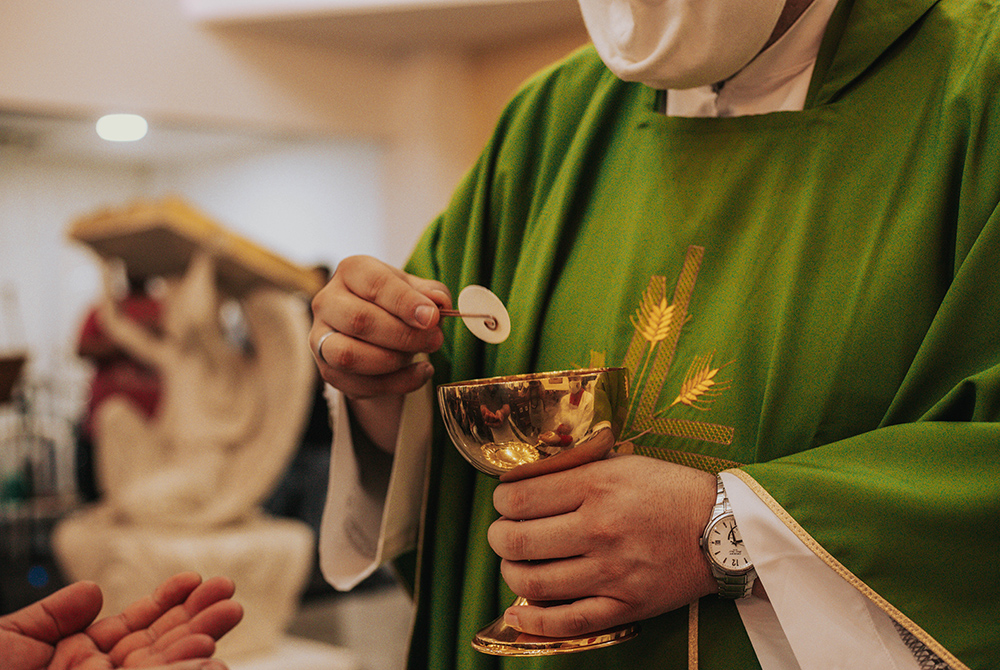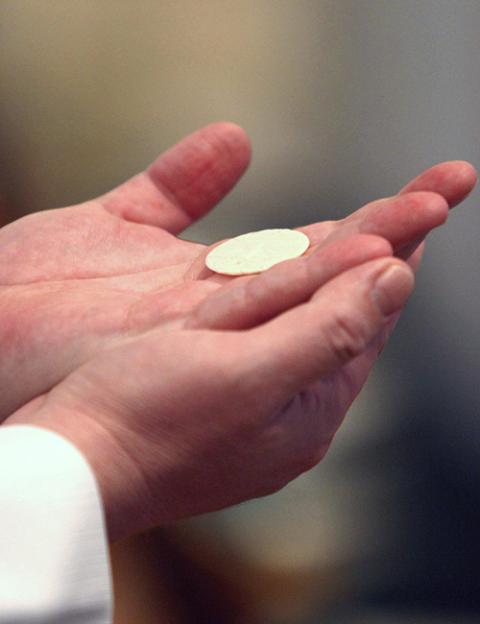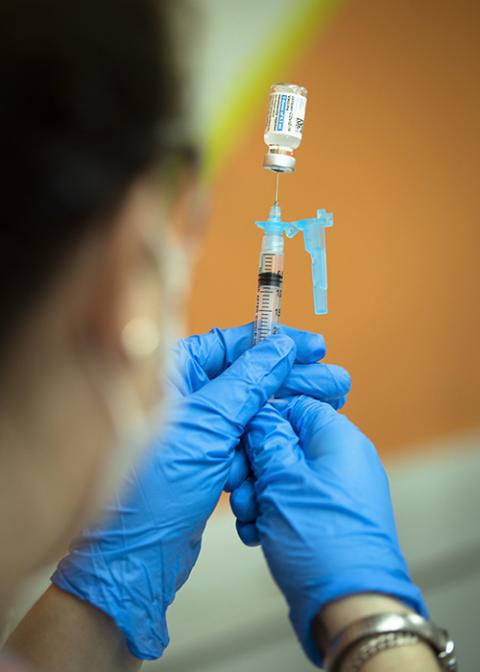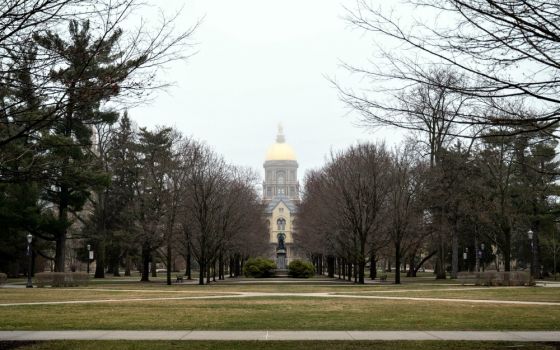
(Unsplash/Thays Orrico)
In a state in the Western U.S., two parishes a few miles apart had such different approaches for implementing the diocesan COVID-19 protocols that some longtime members switched parishes in frustration with their home congregations and pastors.
NCR spoke with several people in each parish, all of whom were candid about feeling hurt by how their pastors responded to the pandemic. All requested to tell their stories on background (meaning the conversation was on the record, but the speakers would not be identified) for fear of repercussions. In the two towns of just a few thousand people each, everyone's lives tend to intersect in work, school, recreation and business, as well as at church.
To hear some members tell it, one church, Parish A, was dangerously careless in its loose adherence to the mandated precautions. They felt that their fears were dismissed when they tried to tell the pastor they felt unsafe attending Masses where social distancing and wearing of masks were routinely ignored and where the pastor continued to allow people to receive Communion on the tongue. The diocese's official policies at the time required all Massgoers to wear masks, for families to sit apart from others and strongly discouraged distributing the Eucharist on the tongue.

A priest holds a host as he concelebrates Mass in a 2005 file photo. (CNS/Gregory A. Shemitz, Long Island Catholic)
Feeling unsafe and unwelcome, those who felt uncomfortable in their own parish began attending Mass in the adjacent town, where precautions were followed scrupulously. Others returned to online-only participation in Mass.
Yet some people from the scrupulously cautious parish, Parish B, also thought they were treated dismissively by that pastor when they asked him to relax precautions, such as to allow the youth group to meet and for friends to sit together. At the time, vaccines were unavailable, although that state's spread of COVID-19 was relatively controlled.
Parishioners at Parish B chose to drive farther to Parish A, where they thought the pastor empowered them to make up their own minds about how to keep themselves safe, even if it meant sitting unmasked. One woman explained that she was happy to have her family sit with friends, trusting that both families were taking adequate COVID-19 precautions to ignore seating protocol.
Whether a parish's or a diocese's coronavirus precautions were appropriate or unnecessarily oppressive left some people feeling at odds with their churches. Others felt abandoned in a difficult time and questioned whether their church — local or writ large — is still "their" church. In the aftermath of the pandemic, dioceses and parishes will need to take a hard look at how the last 16 months affected people's relationships with their faith communities.
As churches closed to prevent the spread of illness in spring 2020, some people continued to build their Sunday mornings around their usual Mass at their home parish, albeit in front of a computer screen. But others "prayed around" and found online Masses streaming from across town — or in another part of the world — that had more dynamic preachers or felt more in tune with the viewers' perspectives or politics.
Now, people of faith, dioceses, parishes and all their component organizations must consider whether in-person participation will again be the only way to be an active Catholic and whether the last 16 months of disruption has irreparably changed the role of church in people's lives.
"This is the great reckoning for the institutional church," said Timothy O'Malley, academic director of the Center for Liturgy at the University of Notre Dame's McGrath Institute for Church Life. "A pandemic is never just about illness. Pandemics are about society" and they bring long-simmering areas of conflict to the front burner.
"I'm concerned about the lack of communion in the church," O'Malley said. "If we can't get across this divide [about approaches to masking] how are we going to get past other divides?"

(Unsplash/Noah)
Politics and parishes
The COVID-19 pandemic played out most visibly in American society as political differences. Tensions from lockdown, closed schools, churches and businesses due to the spreading disease were exacerbated by whether one's thinking about the deadly virus was linked to supporting or opposing former President Donald Trump, who downplayed and politicized the need to wear masks and take other precautions against the coronavirus.
Within the Catholic Church in the United States those simmering areas of tension also connected to politics — both church politics and the government kind, according to O'Malley. But rather than playing out as street protests, within the church, politics-based stress sometimes played out as disagreements about diocesan and parish precautions against the coronavirus.
For the people NCR interviewed from both parishes, the sense that their own pastor didn't care enough about their interests was strong. Everyone interviewed described deeply hurt feelings that they weren't sure would ease after the pandemic passes. That kind of experience is what O'Malley thinks will haunt the church.
"I don't think people are going to come flocking back to church," he said. The tensions affecting those two western parishes are just part of the factors contributing to what he predicts will be a decrease in Mass attendance around the country even once churches are running at "normal" schedules.
"That was coming anyway," he said. "This pandemic period is just accelerating the disaffection trend that was underway."
People who would permanently leave their parish because of how it responded to the pandemic likely already felt dissatisfied with their congregation or its leadership, he said. Their pandemic experience could well have been the last straw for some.
In his own Indiana parish, O'Malley said, some parishioners were angry about the strict mask policy and temporarily went elsewhere. "There were some pretty bitter feelings," he said. "But they are coming back" now that restrictions are easing and vaccinations are more prevalent.

A health care worker at Catholic Charities in Washington prepares to administer the Johnson & Johnson COVID-19 vaccine May 18. (CNS/Tyler Orsburn)
From the start of the pandemic, church leaders have been grappling with how to minister under circumstances nobody had trained to expect.
Jamie Maloney, who chairs the board of the National Association for Lay Ministry, said that soon after everything locked down in spring 2020, the NALM board launched a series of online listening sessions. The National Association for Lay Ministry is a collaborative organization of lay, religious and ordained ministers. The virtual gatherings allowed members to share their experiences, discuss their challenges and hash out together the steps forward, she said.
"At the beginning, lots of people were in a panic," she said. Some churches simply suspended liturgies altogether. Most pastoral leaders, however, realized that in order to keep their parish communities together, they would need to come up with the resources to offer Masses online. Such capabilities had been debated in many places for years, "but this forced it," was how some participants in the sessions described their decisions to invest in technology.
Now, she said, "it can't go away completely." While pastors may believe "everyone wants to go back [in person], that's not really what everyone wants."
Maloney said in her own parish, some parents of young children are reluctant to bring them back to church. "Enough said, 'not until school is out and they're vaccinated' " that an online Mass option has continued, even after the end of the school year.
Of course there is no contemporary template for recovering from a pandemic that shut down much of the world for more than a year, and O'Malley played devil's advocate with his own prediction of a rocky period ahead. He wondered if, after a long imposed exile, people will have a stronger desire than before to participate in sacraments in person and to be a part of a faith community that gathers for worship and lingers over coffee and doughnuts.
Either way, he said dioceses should be focusing on strategies to welcome people back and encourage them to want to be a part of parish life again. "They should be working on how to build unity, how to create a sense of solidarity and how to reestablish reverence and desire for the Eucharist."
(Pixabay/pixel2013)
The good stories
Both O'Malley and Maloney said they think a way forward for the church will have to start with addressing anger and hurt, like what played out in the two neighboring western parishes. But it should also include learning from places that seemed to find the right balance of protecting people, making parishioners continue to feel a part of a community and addressing their fears while isolated and stuck at home or dealing with illness.
"We have to tell the good stories," O'Malley said. For instance, he cited a handful of New York priests who chose to live at nursing homes during the height of the lockdown so they could minister to the residents.
Maloney said one result of the listening sessions for the National Association for Lay Ministry was that in addition to their struggles, members shared stories about where things were working well.
Bridget Klawitter, pastoral associate at St. Leonard Church in Muskego, Wisconsin, was one of those NALM ministers with a good-news story.
"In many ways we flourished," she said. The core parish staff of eight laypeople plus the pastor leaped into action when the need to close became apparent. "We worked our butts off," she said. The parish of 1,800 families assembled new ministries for technology, cleaning and sewing face masks. Mass was livestreamed daily.
Advertisement
When St. Leonard reopened last summer, lectors and the few music ministers allowed for Mass were trained in new safety procedures. No matter what their normal jobs, the parish staff were pressed into service to welcome people to Mass while also ensuring they were listed on the reservation sheet and that everyone was wearing a face mask.
"It was rare that anyone pushed back on the mask requirement. They saw we were doing it for their own good. And those who didn't want to wear a mask had the option of following the livestream," Klawitter said.
"The key for lay ministry is you have to be prepared to change direction on a dime," she said. "But you have to have the rationale for it and explain that it's not just change for the sake of change."
Local ingenuity and collaboration are what O'Malley said should be the foundation of how the church rebuilds after the pandemic. Time and again through the pandemic, he said, it was local responses that helped communities survive — whether in providing food or helping seniors arrange appointments for vaccines or many other examples. Such grassroots problem-solving needs to be the model for the church to find a way forward, he said.
"We should recognize that the local level has a lot of power," he said. "Ecclesial renewal doesn't happen from the top down. Think of St. Francis of Assisi," whose continuing influence on the church 800 years after his death began with his ministry to the poor and outcast. "Renewal comes from the bottom up."
[Patricia Zapor is a freelance writer who covered federal government for more than two decades and has extensive experience on the topic of immigration.]





